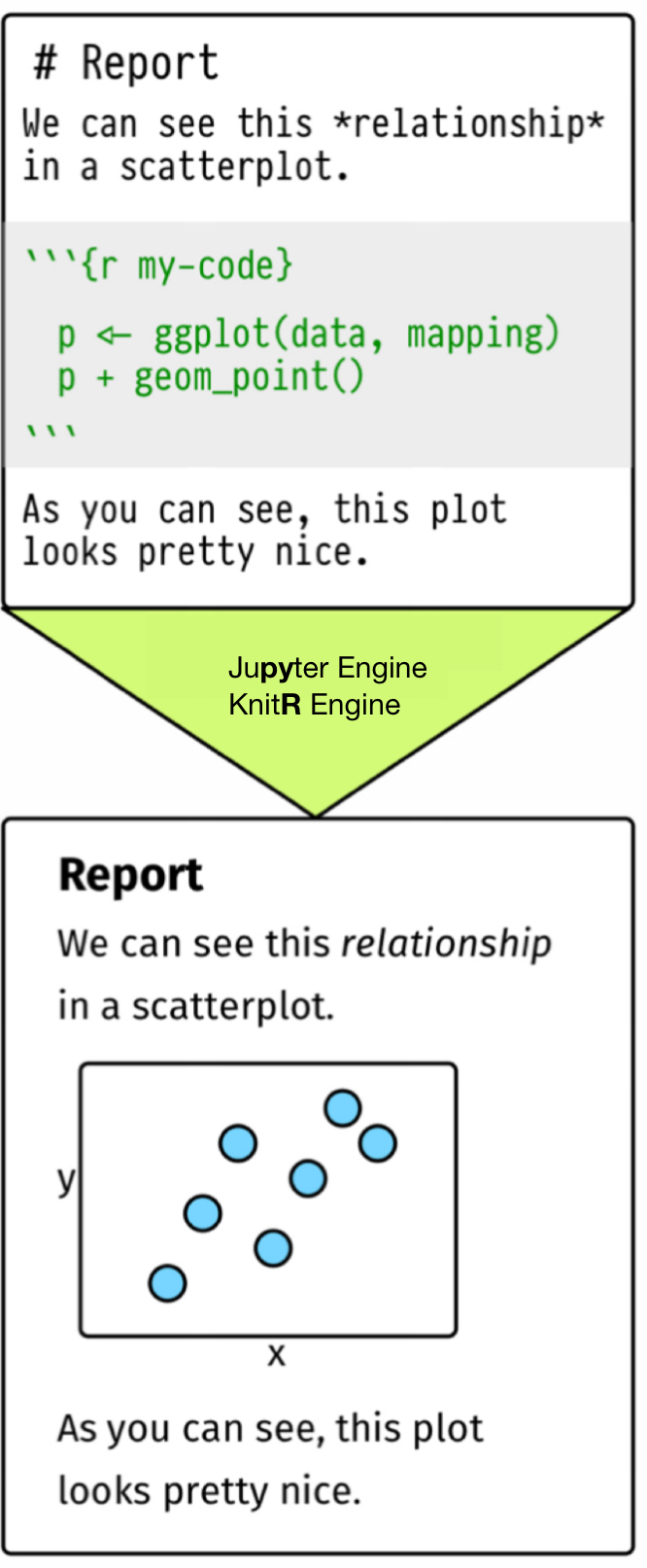Lecture 3
Getting Started with Jupyter Notebook and Quarto
January 27, 2025
Getting Started with Jupyter Notebook and Quarto
Building a Personal Website on GitHub
- Follow steps described in Classwork 1.
Let’s Practice Markdown!
Jupyter Notebook, Quarto, and GitHub-based Discussion Boards use markdown as its underlying document syntax.
Let’s do Classwork 2.
Getting Started with Jupyter Notebook and HTML
YAML

- An YAML (yet another markup language) header surrounded by
---.- It is commonly used for document configuration (e.g., title, author, date, style, …).
Getting Started with Jupyter Notebook and HTML
Knitting / Rendering

When we knit the document, Quarto sends the
.qmdfile to jupyter/knitr, which executes all of the code chunks and creates a new markdown (.md) document which includes the code and its output.The markdown file (
*.md) generated by jupyter/knitr is then processed by pandoc, which is responsible for creating the output file.
Getting Started with Jupyter Notebook and HTML
Markdown, Jupyter Notebook, and HTML
- The very original version of Markdown was invented mainly to write HTML content more easily.
- For example,
- SOME_TEXTin “.md” is equivalent to<ul><li> SOME_TEXT </li>in ”.html”
- For example,
- Pandoc makes it possible to convert a Markdown document to a large variety of output formats, such as HTML.
Getting Started with Jupyter Notebook and HTML
Markdown, Jupyter Notebook, and HTML
- To create an HTML document from Jupyter Notebook, we specify the
htmloutput format in the YAML metadata of our document.- By default,
format: htmlis set.
- By default,
- Open an empty Jupyter Notebook file from Google Colab (or VSCode).
- Create the first cell that is Text.
- Type the above YAML metadata to the first Text cell.
Getting Started with Jupyter Notebook and HTML
Markdown, Jupyter Notebook, and HTML
Download the Jupyter Notebook file,
danl-210-python-basic.ipynbfrom Brightspace, and open it from Google Colab (or VSCode if you prefer).The above syntax is part of YAML metadata in
danl-210-python-basic.ipynb.- YAML should be always in the first cell, and the first cell should be text, not code.
In YAML, indentation really matters!
- tab (or four spaces) defines a level in YAML.
Managing a Website with Jupyter Notebook and Quarto
Quarto Website: _quarto.yml
- In RStudio, open the project
USERNAME.github.io.Rporj.- Click
Project: (None)at the top-right corner. - Click
USERNAME.github.io.Rproj.
- Click
_quarto.ymlconfigures a website, and provides various options for HTML documents within the website.
Quarto Website
Custom CSS
- Cascading Style Sheets (CSS) is used to format the layout of a webpage (color, font, text size, background, display, etc.).
- HTML will format the architecture of the house.
- CSS will be the carpet and walls to decorate the house.
- JavaScript adds interactive elements in the house, such as opening doors and lighting.
- We are not front-end web developers.
- We will not cover the use of CSS and JavaScript.
Quarto Website
Rendering
The Render button (command/Ctrl + shift + K) renders a single Quarto document file (e.g.,
index.qmd) to create an output document.quarto renderfrom Terminal renders ALL Quarto documents and Jupyter Notebook files in your local working directory:
quarto rendershould be used if there is any change in_quarto.yml.
Tip
- Edit
_quarto.yml,*.qmd, or*.ipynbfiles ONLY from your local laptop or Google Colab.- Do not edit them from your GitHub repo for the website.
Quarto Website
Adding *.ipynb to a Quarto website
By default,
quarto renderdoesn’t execute any code in.ipynbnotebooks.quarto renderrenders.ipynbnotebooks, so that correspondinghtmlfiles are rendered.- If you need to update cell outputs in
*.ipynb, run that*.ipynbon Google Colab, save the notebook, and download it to your local working directory.
- If you need to update cell outputs in
Quarto Website
Appearance and Style
themespecifies the Bootstrap theme to use for the page (themes are drawn from the Bootswatch theme library).- Valid themes include
default,bootstrap,cerulean,cosmo,darkly,flatly,journal,lumen,paper,readable,sandstone,simplex,spacelab,united, andyeti.
- Valid themes include
highlight-stylespecifies the code highlighting style.- Supported styles include
default,tango,pygments,kate,monochrome,espresso,zenburn,haddock,breezedark, andtextmate.
- Supported styles include
Quarto Website
About
- Your
index.qmdsets a front page about you.- Details in about pages are available here:
- https://quarto.org/docs/websites/website-about.html.
- Quarto includes 5 built in templates:
jollatrestlessolanamarqueebroadside
Quarto Website
Icons and Emojis
- A ton of Bootstrap icons are available here:
- A ton of markdown emojis are available here 😄:
Quarto Website
Naviation and Adding Pages
- We can add a new page to the website through
navbarin_quarto.yml
Quarto Website
Naviation and Adding Pages
We can also create a drop-down menu by including a
menuMore details about navbar are available here:
Quarto Website Basics
- Let’s do Classwork 3.